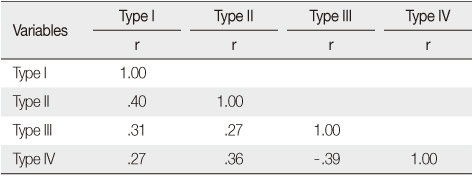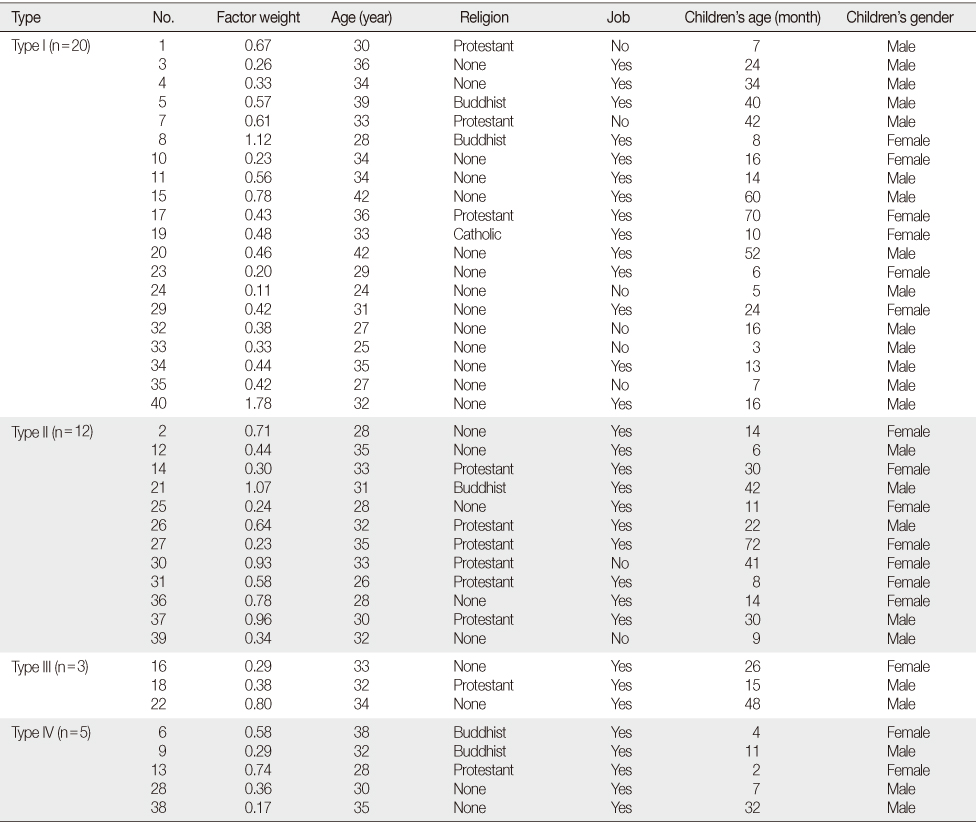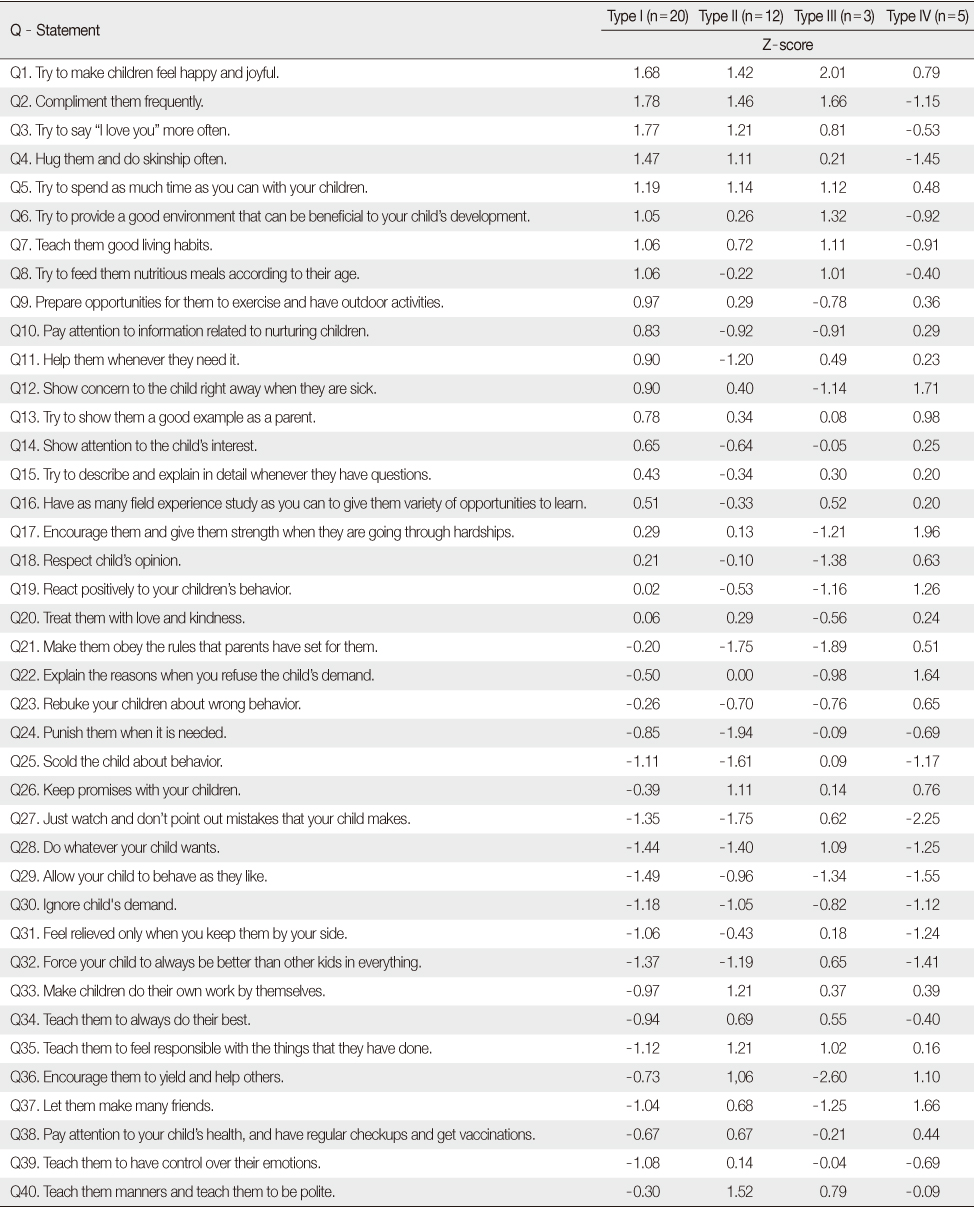Articles
- Page Path
- HOME > J Korean Acad Nurs > Volume 43(4); 2013 > Article
-
Original Article
- Types of Child Rearing Behavior of Parents during Early Childhood: Q-Methodological Approach
- Sun-Jung Park, Kyung-Ah Kang, Shin-Jeong Kim
-
Journal of Korean Academy of Nursing 2013;43(4):486-496.
DOI: https://doi.org/10.4040/jkan.2013.43.4.486
Published online: August 30, 2013
1Graduate School, Sahmyook University, Seoul, Korea.
2Department of Nursing, Sahmyook University, Seoul, Korea.
3Department of Nursing, Hallym University, Chunchon, Korea.
- Address reprint requests to: Kim, Shin-Jeong. Department of Nursing, Hallym University, 1 Okchun-dong, Chunchon 200-702, Korea. Tel: +82-33-248-2721, Fax: +82-33-248-2734, ksj@hallym.ac.kr
© 2013 Korean Society of Nursing Science
Abstract
-
Purpose
- The purpose of this study was to identify the awareness of child rearing among parents of children in early childhood and to provide fundamental data for parent education programs according to child rearing type.
-
Methods
- Q-methodology which provides a method of analyzing the subjectivity of each item was used. Forty Q items which were derived from a literature review and interviews with nurturing mothers were classified into a normal distribution using a 9-point scale. Collected data were analyzed using the QUANAL PC Program.
-
Results
- Four types of parents' child rearing were identified. Type I was named 'affection-respect type', type II, 'concern-rule compliant type', type III, 'solicitude-model type', and type IV, 'geniality-encouragement type'.
-
Conclusion
- For proper growth and development during early childhood, parents should have rational information and awareness of their child rearing type. Results of this study can be used as essential data to develop child rearing education programs according to parents' child rearing attitude.
- 1. Arredondo EM, Elder JP, Ayala GX, Campbell N, Baquero B, Duerksen S. Is parenting style related to children's healthy eating and physical activity in Latino families? Health Educ Res. 2006;21(6):862–871. http://dx.doi.org/10.1093/her/cyl110ArticlePubMed
- 2. Bang KS, Kwon MK, Choi MY, Huh BY, Chung SJ. Perception of the importance of health promotion behavior for infants and toddlers according to mothers of children in this age group and graduate students in nursing. J Korean Acad Child Health Nurs. 2012;18(2):60–67. http://dx.doi.org/10.4094/jkachn.2012.18.2.60Article
- 3. Clark KE, Ladd GW. Connectedness and autonomy support in parent-child relationships: Links to children's socioemotional orientation and peer relationships. Dev Psychol. 2000;36(4):485–498.ArticlePubMed
- 4. Dennis KE. Q methodology: Relevance and application to nursing research. ANS Adv Nurs Sci. 1986;8(3):6–17.PubMed
- 5. Duffy ME. Primary prevention behaviors: The female-headed, one-parent family. Res Nurs Health. 1986;9(2):115–122.ArticlePubMed
- 6. Gross D, Conrad B, Fogg L, Wothke W. A longitudinal model of maternal self-efficacy, depression, and difficult temperament during toddlerhood. Res Nurs Health. 1994;17(3):207–215.ArticlePubMed
- 7. Han JA. Children's self-perceived competencea and mothers' children's self-perceived competencea and mothers' low income intact and divorced families. J Korean Counc Child Rights. 2010;14(3):355–384.
- 8. Han KJ, Yi YH, Sim IO, Choi YJ. Dimensions and attributes of quality of life in Korean school-age children. Korean J Child Health Nurs. 2005;11(2):167–178.
- 9. Hwang YS. A study of factors influencing suicidal ideation among adolescents: Focusing on the home & school environment. Jinju, Gyeongsang National University. 2003;Unpublished master's thesis.
- 10. Hyun JH. A review on the recent trends in the parent-child relations in Korea. Korean J Child Educ Care. 2007;7(1):95–110.
- 11. Igoe JB, Giordano BP. Health promotion and disease prevention: Secrets of success. Pediatr Nurs. 1992;18(1):61–62. 66. PubMed
- 12. Kim HK. Understanding & application of Q methodology. Seoul: Mass Communication, Sogang University; 1990.
- 13. Kim HK. Q methodology: Philosophy, theories, analysis, and application. Seoul: Communicationbooks; 2008.
- 14. Kim HM, Doh HS. Maternal parenting stress, efficacy, and behavior: Relations to children's social competence. Korean J Child Stud. 2004;25(6):279–298.
- 15. Kim SJ, Kang KA, Yun J, Kwon OJ. Development of a tool to measure health promotion behavior for infants & toddlers. J Korean Acad Child Health Nurs. 2007;13(1):21–32.
- 16. Kim YE, Cho BH, Jung MJ. Prevalence study of mothers' perception on pregnancy, childbirth, and childcare: Comparison between years 2002 and 2007. J Korean Child Care Educ. 2007;3(2):68–85.
- 17. Koh MS. Influence of parents' child rearing attitudes on family cohesion and self-esteem in adolescents. J Korean Acad Child Health Nurs. 2010;16(3):195–202. http://dx.doi.org/10.4094/jkachn.2010.16.3.195
- 18. Kwon M, Bang K, Kim N, Ahn H. Perception on the importance of parental role by mothers with infants. J Korean Acad Child Health Nurs. 2006;12(2):170–179.
- 19. Laible DJ. Parent-child conflict in the toddler years: Lessons in emotion, morality, and relationships. Lincoln, NE, University of Nebraska-Lincoln. 2000;Unpublished doctoral dissertation.
- 20. Minjung Publishing Co. Minjung's essence Korean-English dictionary. 4th ed. Seoul: Minjung Publishing Co; 2000.
- 21. Moon YS, Han JS. The relationships between mother's child caring behavior and child behavioral problems. Korean Parent Child Health J. 2002;5(2):161–176.
- 22. Oh JA. Concept analysis of the childcare. Nurs Sci. 2000;12(2):26–36.
- 23. Oh J. Care stress and quality of life of grandmothers caring for their grandchildren in employment mother's home. J Korean Acad Child Health Nurs. 2006;12(3):368–376.
- 24. Park JH, Rhee UH. Children's peer competence: Relationships to maternal parenting goals, parenting behaviors, and management strategies. Korean J Child Stud. 2001;22(4):1–15.
- 25. Park KJ. Q-sort description on maternal behaviors of one-year-old infants. J Korean Home Econ Assoc. 2001;39(1):137–149.
- 26. Wake M, Nicholson JM, Hardy P, Smith K. Preschooler obesity and parenting styles of mothers and fathers: Australian national population study. Pediatrics. 2007;120(6):e1520–e1527. http://dx.doi.org/10.1542/peds.2006-3707ArticlePubMedPDF
- 27. Yang MS, Kim YE. A study on the level of mother's parenting stress. J Korean Child Care Educ. 2012;8(3):229–247.
- 28. Yune HS, Oh KJ. The effect of social support on parenting stress among families in poverty: Focused on children's age and environmental risk factors. Korean J Woman Psychol. 2010;15(4):673–689.Article
REFERENCES
Figure & Data
REFERENCES
Citations

- Motherhood Ideology and Parenting Stress according to Parenting Behavior Patterns of Married Immigrant Women with Young Children
So-Hyun Moon, Miok Kim, Hyeun Na
Journal of Korean Academy of Nursing.2019; 49(4): 449. CrossRef - Development of a Measurement Instrument for Parenting Behavior of Primary Caregivers in Early Childhood
Sun-Jung Park, Kyung-Ah Kang
Journal of Korean Academy of Nursing.2015; 45(5): 650. CrossRef - A study on the types of gender role identity in middle-aged men using Q methodology
Sung-Hee Ko, Myung-Ae Kim, Euna Park
Journal of the Korea Academia-Industrial cooperation Society.2014; 15(7): 4361. CrossRef
Eigen Value, Variance, and Cumulative Percentage (N=40)
Type I=Affection-respect type; Type II=Concern-rule compliant type; Type III=Solicitude-model type; Type IV=Geniality-encouragement type.
Correlation Matrix between Types (N=40)
Type I=Affection-respect type; Type II=Concern-rule compliant type; Type III=Solicitude-model type; Type IV=Geniality-encouragement type.
Demographic Characteristics and Factor Weight for P-sample (N=40)
Type I=Affection-respect type; Type II=Concern-rule compliant type; Type III=Solicitude-model type; Type IV=Geniality-encouragement type.
Q-Statements on Z-Scores according to Types (N=40)
Type I=Affection-respect type; Type II=Concern-rule compliant type; Type III=Solicitude-model type; Type IV=Geniality-encouragement type.
Consensus Items and Average Z-scores (N=40)
Type I=Affection-respect type; Type II=Concern-rule compliant type; Type III=Solicitude-model type; Type IV=Geniality-encouragement type.
Type I=Affection-respect type; Type II=Concern-rule compliant type; Type III=Solicitude-model type; Type IV=Geniality-encouragement type.
Type I=Affection-respect type; Type II=Concern-rule compliant type; Type III=Solicitude-model type; Type IV=Geniality-encouragement type.
Type I=Affection-respect type; Type II=Concern-rule compliant type; Type III=Solicitude-model type; Type IV=Geniality-encouragement type.
 KSNS
KSNS
 E-SUBMISSION
E-SUBMISSION





 Cite
Cite

